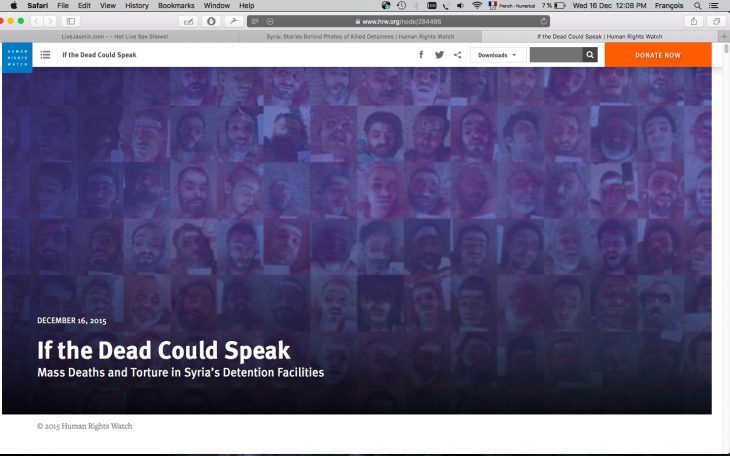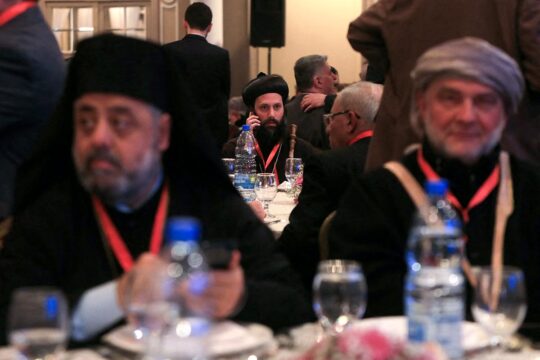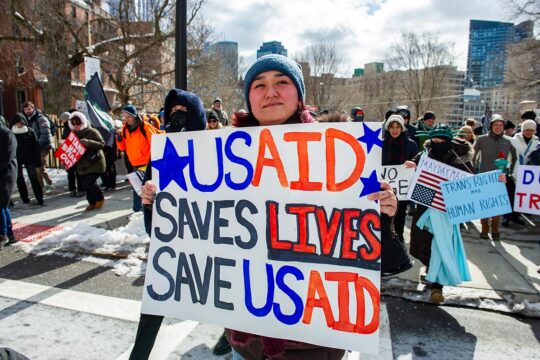Nine months of research reveals some of the human stories behind the more than 28,000 photos of deaths in government custody that were smuggled out of Syria and first came to public attention in January 2014, Human Rights said in a report and accompanying video released today.
The 86-page report, “If the Dead Could Speak: Mass Deaths and Torture in Syria’s Detention Facilities,” lays out new evidence regarding the authenticity of what are known as the Caesar photographs, identifies a number of the victims, and highlights some of the key causes of death. Human Rights Watch located and interviewed 33 relatives and friends of 27 victims whose cases researchers verified; 37 former detainees who saw people die in detention; and four defectors who worked in Syrian government detention centers or the military hospitals where most of the photographs were taken. Using satellite imagery and geolocation techniques, Human Rights Watch confirmed that some of the photographs of the dead were taken in the courtyard of the 601 Military Hospital in Mezze.
“Just about every detainee in these photographs was someone’s beloved child, husband, father, or friend, and his friends and family spent months or years searching for him,” said Nadim Houry, deputy Middle East director at Human Rights Watch. “We have meticulously verified dozens of stories, and we are confident the Caesar photographs present authentic – and damning – evidence of crimes against humanity in Syria.”
The 86-page report, “If the Dead Could Speak: Mass Deaths and Torture in Syria’s Detention Facilities,” lays out new evidence regarding the authenticity of what are known as the Caesar photographs, identifies a number of the victims, and highlights some of the key causes of death. Human Rights Watch located and interviewed 33 relatives and friends of 27 victims whose cases researchers verified; 37 former detainees who saw people die in detention; and four defectors who worked in Syrian government detention centers or the military hospitals where most of the photographs were taken. Using satellite imagery and geolocation techniques, Human Rights Watch confirmed that some of the photographs of the dead were taken in the courtyard of the 601 Military Hospital in Mezze.
“Just about every detainee in these photographs was someone’s beloved child, husband, father, or friend, and his friends and family spent months or years searching for him,” said Nadim Houry, deputy Middle East director at Human Rights Watch. “We have meticulously verified dozens of stories, and we are confident the Caesar photographs present authentic – and damning – evidence of crimes against humanity in Syria.”
Countries meeting about possible peace negotiations in Syria – including Russia, as the Syrian government’s biggest backer – should make the fate of the thousands of detained people in Syria a priority, Human Rights Watch said. Concerned countries should insist that the Syrian government give international monitors immediate access to all detention centers and that Syria’s intelligence services must stop forcibly disappearing and torturing detainees.
In August 2013, a military defector code-named Caesar smuggled 53,275 photographs out of Syria. Human Rights Watch received the full set of images from the Syrian National Movement, a Syrian anti-government political group that received them from Caesar. The report focuses on 28,707 of the photographs that, based on all available information, show at least 6,786 detainees who died in detention or after being transferred from detention to a military hospital. The remaining photographs are of attack sites or of bodies identified by name as of government soldiers, other armed fighters, or civilians killed in attacks, explosions, or assassination attempts.
Most of the 6,786 victims shown in the Caesar photographs were detained by just five intelligence agency branches in Damascus, and their bodies were sent to at least two military hospitals in Damascus between May 2011, when Caesar began copying files and smuggling them out of his workplace, and August 2013, when he fled Syria. The Syrian Network for Human Rights has documented the arrest and detention of more than 117,000 people in Syria since March 2011.
Human Rights Watch found evidence of widespread torture, starvation, beatings, and disease in Syrian government detention facilities. Researchers identified 27 people shown in the photographs and documented their arrest by Syrian intelligence agencies and, in some cases, their ill-treatment and torture in detention. They collected families’ accounts of how their relatives were arrested; compared identifying marks, scars, and tattoos; and sought evidence from former detainees held at the same time, sometimes in the same cell, as the victims. They compared this data to information contained in the names of files that Caesar collected, as well as the information shown on white cards on the victim’s body in each photograph for identification. The case verifications are not forensic or legal identifications; however, Human Rights Watch only included cases with verification from multiple sources in the report.
Among the victims identified are a boy who was 14 at the time of his arrest, and a female activist in her 20s. All of the 27 families or relatives interviewed said they spent months or years searching for news of their loved ones, in many cases paying huge sums to contacts and middlemen employed in various government or security agencies. Only two eventually received death certificates which said the deceased had died of heart or respiratory failure. None received the bodies of their relatives for burial.
Human Rights Watch shared a subset of the photographs, showing 19 victims, with a team of forensic pathologists from Physicians for Human Rights, who analyzed the photos for signs of abuse, as well as evidence of the cause of death. The forensic pathologists found evidence of several types of torture, starvation, suffocation, violent blunt force trauma, and in one case, a gunshot wound in the head, concluding that the victim had been shot in the head at close range.
The former detainees, held in the same places as most of the Caesar victims, told Human Rights Watch that guards kept them in severely overcrowded cells with very little air circulation, gave them so little food that they grew weak, and often denied them the opportunity to wash. Skin diseases and other infectious diseases proliferated, and detainees said that guards denied them adequate medical care.
“We have no doubt that the people shown in the Caesar photographs were starved, beaten, and tortured in a systematic way, and on a massive scale,” Houry said. “These photographs represent just a fraction of people who have died while in Syrian government custody – thousands more are suffering the same fate.”
Human Rights Watch researchers used satellite geolocation techniques and the evidence of defectors from the two military hospitals to confirm where the photos were taken and identified a coding system for the cards placed on the bodies.
“The government registered these deaths, processing dozens of bodies at a time, while taking no action to investigate the cause of death or to prevent yet more people in their custody from dying,” Houry said. “Those pushing for peace in Syria should ensure that these crimes stop and that the people who oversaw this system ultimately face accountability for their crimes.”
In addition to granting international monitors immediate access to all of its detention facilities, the Syrian government should release all arbitrarily detained and political prisoners, Human Rights Watch said. Russia and Iran, as the main backers of the government, have a particular responsibility to press Syria for immediate and unhindered access for recognized international monitors of detention.
Countries that are members of the International Syria Support Group (ISSG), which has been meeting in Vienna to push for a Syrian peace process, should support efforts to ensure accountability for the widespread abuses committed by all sides in Syria. Proposals to grant immunity to anyone implicated in serious crimes should be rejected. As a minimum part of any transitional process in Syria, individuals against whom there is credible evidence of involvement in torture or other serious crimes should not have positions of authority in the detention system, Human Rights Watch said.
“Many of the former detainees who were held in these nightmarish conditions told us they often wished they would die, rather than continue suffering,” Houry said. “They begged countries involved in seeking a peace process to do everything they can to help the people still being held in Syria.”
In August 2013, a military defector code-named Caesar smuggled 53,275 photographs out of Syria. Human Rights Watch received the full set of images from the Syrian National Movement, a Syrian anti-government political group that received them from Caesar. The report focuses on 28,707 of the photographs that, based on all available information, show at least 6,786 detainees who died in detention or after being transferred from detention to a military hospital. The remaining photographs are of attack sites or of bodies identified by name as of government soldiers, other armed fighters, or civilians killed in attacks, explosions, or assassination attempts.
Most of the 6,786 victims shown in the Caesar photographs were detained by just five intelligence agency branches in Damascus, and their bodies were sent to at least two military hospitals in Damascus between May 2011, when Caesar began copying files and smuggling them out of his workplace, and August 2013, when he fled Syria. The Syrian Network for Human Rights has documented the arrest and detention of more than 117,000 people in Syria since March 2011.
Human Rights Watch found evidence of widespread torture, starvation, beatings, and disease in Syrian government detention facilities. Researchers identified 27 people shown in the photographs and documented their arrest by Syrian intelligence agencies and, in some cases, their ill-treatment and torture in detention. They collected families’ accounts of how their relatives were arrested; compared identifying marks, scars, and tattoos; and sought evidence from former detainees held at the same time, sometimes in the same cell, as the victims. They compared this data to information contained in the names of files that Caesar collected, as well as the information shown on white cards on the victim’s body in each photograph for identification. The case verifications are not forensic or legal identifications; however, Human Rights Watch only included cases with verification from multiple sources in the report.
Among the victims identified are a boy who was 14 at the time of his arrest, and a female activist in her 20s. All of the 27 families or relatives interviewed said they spent months or years searching for news of their loved ones, in many cases paying huge sums to contacts and middlemen employed in various government or security agencies. Only two eventually received death certificates which said the deceased had died of heart or respiratory failure. None received the bodies of their relatives for burial.
Human Rights Watch shared a subset of the photographs, showing 19 victims, with a team of forensic pathologists from Physicians for Human Rights, who analyzed the photos for signs of abuse, as well as evidence of the cause of death. The forensic pathologists found evidence of several types of torture, starvation, suffocation, violent blunt force trauma, and in one case, a gunshot wound in the head, concluding that the victim had been shot in the head at close range.
The former detainees, held in the same places as most of the Caesar victims, told Human Rights Watch that guards kept them in severely overcrowded cells with very little air circulation, gave them so little food that they grew weak, and often denied them the opportunity to wash. Skin diseases and other infectious diseases proliferated, and detainees said that guards denied them adequate medical care.
“We have no doubt that the people shown in the Caesar photographs were starved, beaten, and tortured in a systematic way, and on a massive scale,” Houry said. “These photographs represent just a fraction of people who have died while in Syrian government custody – thousands more are suffering the same fate.”
Human Rights Watch researchers used satellite geolocation techniques and the evidence of defectors from the two military hospitals to confirm where the photos were taken and identified a coding system for the cards placed on the bodies.
“The government registered these deaths, processing dozens of bodies at a time, while taking no action to investigate the cause of death or to prevent yet more people in their custody from dying,” Houry said. “Those pushing for peace in Syria should ensure that these crimes stop and that the people who oversaw this system ultimately face accountability for their crimes.”
In addition to granting international monitors immediate access to all of its detention facilities, the Syrian government should release all arbitrarily detained and political prisoners, Human Rights Watch said. Russia and Iran, as the main backers of the government, have a particular responsibility to press Syria for immediate and unhindered access for recognized international monitors of detention.
Countries that are members of the International Syria Support Group (ISSG), which has been meeting in Vienna to push for a Syrian peace process, should support efforts to ensure accountability for the widespread abuses committed by all sides in Syria. Proposals to grant immunity to anyone implicated in serious crimes should be rejected. As a minimum part of any transitional process in Syria, individuals against whom there is credible evidence of involvement in torture or other serious crimes should not have positions of authority in the detention system, Human Rights Watch said.
“Many of the former detainees who were held in these nightmarish conditions told us they often wished they would die, rather than continue suffering,” Houry said. “They begged countries involved in seeking a peace process to do everything they can to help the people still being held in Syria.”






